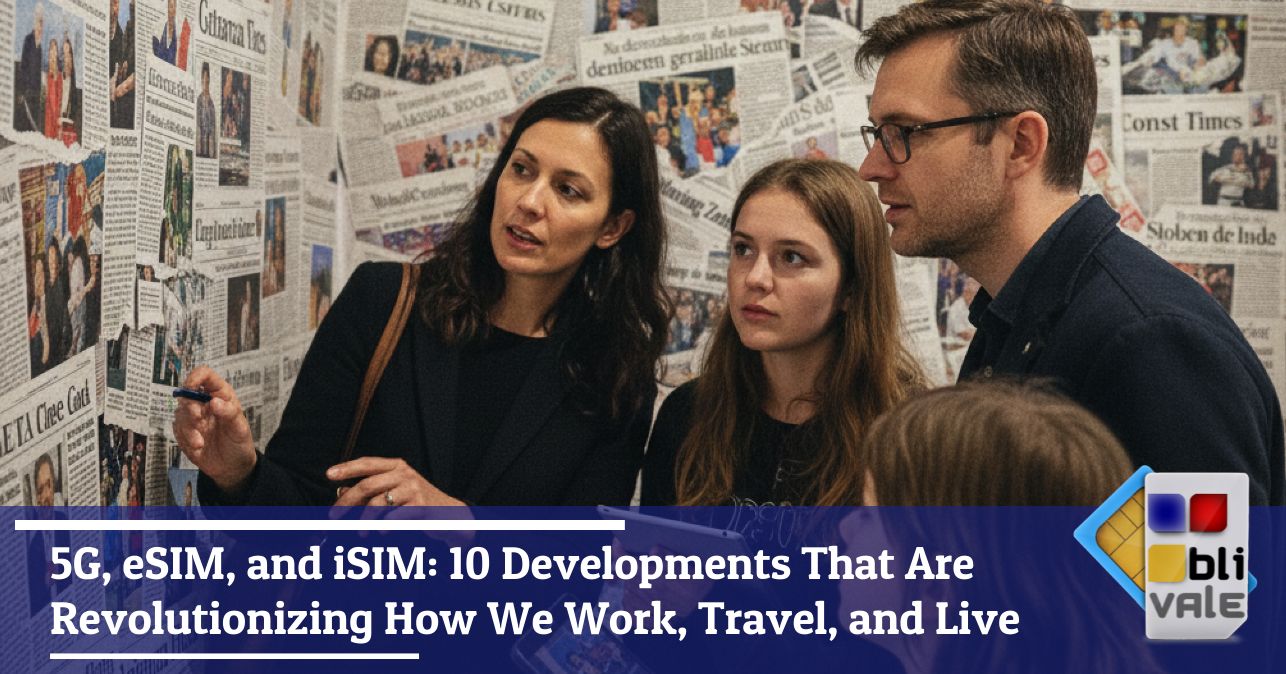The Connectivity Revolution: 10 News Stories That Are Changing the World of Telecommunications
Week of October 25 - November 1, 2025
An Era of Digital Transformation
This past week marked a pivotal moment for the telecommunications industry. As the world continues its race toward increasingly intelligent and flexible connectivity, eSIMs, iSIMs, and 5G technologies are completely redefining the way we connect, travel, and work. Whether you're a mobile professional, an avid traveler, or simply someone who wants to stay ahead of the curve, this week brought developments that deserve your attention.
In an age where connectivity is no longer a luxury but a vital necessity, understanding these transformations is essential. Here are the 10 key developments shaping the future of telecommunications.
The 10 News of the Week
1. The Challenges of eSIM Transfer: The Broken Promise
Despite promises of simplicity, transferring eSIMs between devices continues to present significant obstacles. According to an in-depth analysis, users still face cryptic error codes and lengthy customer support calls when attempting to migrate their mobile service to a new device. The main problem is that you don't actually "transfer" an eSIM profile; instead, you request a new one by deleting the old one. This process, especially when switching from iOS to Android or vice versa, remains fragile and unintuitive.
Link: eSIM Switching Woes Continue Despite New Tools
2. AT&T Completes National Standalone 5G Rollout
AT&T has reached a major milestone by completing the nationwide deployment of its 5G Standalone (SA) network. Unlike non-standalone 5G, which relies on 4G LTE infrastructure, this new deployment is a fully independent 5G network, built specifically for the next generation of wireless. The technology enables advanced capabilities such as faster upload speeds, ultra-low latency, extreme reliability, and edge features. The company also announced that its 5G Reduced Capability (RedCap) technology is operational nationwide, already supporting the new Apple Watch Series 11, Ultra 3, and SE 3.
Link: AT&T 5G Standalone Nationwide
3. T-Mobile Launches Edge Control: A New Era for Private Enterprise 5G
T-Mobile has introduced Edge Control, a pseudo-private 5G service that leverages its advanced 5G infrastructure to deliver private network performance with lower costs and complexity. Built on the company's 5G Advanced network, the service integrates network slicing and Mobile Edge Computing (MEC) to offer businesses an alternative between unreliable Wi-Fi and expensive private cellular networks. In parallel, it has launched T-Platform, an enterprise management platform covering the full range of device and connectivity management, including IoT fleets.
Link: T-Mobile Pushes Home 5G Advantage with Hybrid Private 5G Offer
4. Verizon Expands Home Internet with Affordable Lite Plan
Verizon has launched a new Home Internet Lite plan, aimed at connecting customers with limited connectivity options or looking for low-cost solutions. The service offers download speeds of up to 25 Mbps and is available starting at just $25 per month for a limited time for Verizon mobile customers. After the first 150 GB of monthly data usage, speeds are reduced to 10 Mbps with unlimited data for the remainder of the billing cycle. The free router and self-service setup make access simple and immediate.
Link: Verizon Expands Home Internet to More Customers with New Lite Plan
5. AT&T Sees Record Growth in 5G Home Internet
AT&T reported impressive growth in its broadband services during the third quarter of 2025. The company welcomed 270,000 new subscribers for AT&T Internet Air, its 5G wireless home internet offering, and added 288,000 customers for AT&T Fiber. Consumer fiber broadband revenue rose to $2.2 billion for the quarter, marking a robust 16.8% increase compared to the same period in 2024. This growth demonstrates how the maturation of 5G is democratizing high-speed internet access.
If you are thinking of taking a trip alone or with friends or for work, do not forget the importance of staying connected wherever you are. For unlimited Internet connection, contact BLIVALE where you can get unlimited Internet according to the destinations:
For unlimited plans like data BLIVALE guarantees free roaming anywhere in the world, no additional or hidden costs. Don't let the lack of connection stop you; get ready to explore the world with freedom and spontaneity.
6. iSIM Market Projected to Reach 300 Million Units by 2027
The release of commercially certified iSIMs by companies like Qualcomm and Thales has the potential to spark a trend toward mass adoption of this new eSIM technology. According to research by Kaleido Intelligence, the iSIM market will grow to 300 million units by 2027, representing 19% of all eSIM shipments. The iSIM integrates directly into the device's processor, eliminating the need for a physical SIM card or an eSIM soldered onto a printed circuit board, further simplifying the production process for IoT device manufacturers.
Link: iSIM Opens a New World of Opportunity for Mobile and IoT Innovation
7. Only 33% of Cellular IoT Modules Use eSIM Technology
According to IoT Analytics' IoT eSIM Modules and iSIM Chipsets Market Tracker, the installed base of eSIM-compatible IoT connectivity modules (including iSIM) will reach 650 million in 2023. However, currently only a third of all cellular IoT modules shipped support eSIM technology. Analysts expect accelerated growth in cellular IoT modules with eSIM technology starting in the second half of 2025, driven by the release of the GSMA's SGP.31 and SGP.32 specifications.
Link: The Role of eSIM for IoT: Only 33% of Cellular IoT Devices Use It
8. 5G Fixed Wireless Access Will Reach 150 Million Global Subscriptions by 2030
According to Omdia forecasts, 5G Fixed Wireless Access (FWA) will reach 150 million subscriptions globally by 2030. This approach reflects the broader future of the telecommunications industry, with FWA expanding the possibilities for mobile broadband bundles and creating upselling opportunities. The growth of FWA is redefining the home connectivity landscape, offering a competitive alternative to traditional wired connections.
Link: 5G Fixed Wireless Access to Reach 150M Subscriptions Globally by 2030
9. 2025: A Critical Year for eSIM Management: Growth Prospects of 16.5% CAGR
The eSIM market is gaining momentum, with key players from Infineon to STMicroelectronics, Thales, Sierra Wireless, KORE, and Valid demonstrating its global importance. Analysts forecast a CAGR of 16.5% from 2025 to 2032, rising from $14.7 billion in 2024 to approximately $50 billion by 2032. With the technology celebrating its ninth anniversary in March 2025, the time to capitalize on this opportunity is now. Analysts also expect annual IoT eSIM sales to double by 2025.
Link: 2025 in eSIM Management: A Critical Year?
10. FCC to Vote to Eliminate Cybersecurity Requirements for Telecommunications
In a controversial move, the Federal Communications Commission (FCC) will vote in November on eliminating cybersecurity requirements for telecommunications carriers. FCC Chairman Brendan Carr announced that the November agenda will include a vote to rescind the January 15 declaration that the Communications Assistance for Law Enforcement Act (CALEA) of 1994 "affirmatively requires telecommunications carriers to protect their networks from unauthorized access to or interception of communications." This decision comes after massive Chinese cyberattacks on US telecommunications.
Link: FCC Will Vote to Scrap Telecom Cybersecurity Requirements
Conclusion: The Trend of the Week
The week of October 25 to November 1, 2025, highlighted a clear direction: the convergence of ease of use and technological complexity . While eSIM and iSIM technologies promise to radically simplify connectivity, the reality on the ground shows that there is still a long way to go to achieve the promised true "seamless experience."
The dominant trend is the democratization of high-speed internet access through 5G FWA and hybrid solutions. AT&T, T-Mobile, and Verizon are all investing heavily in models that bring high-quality connectivity to previously underserved areas, redefining the concept of the "digital divide."
At the same time, a tension emerges between innovation and security : as the industry pushes toward smarter, more virtualized, and API-driven networks, cybersecurity concerns (as highlighted by the FCC decision) remain a sticking point that could slow mass adoption.
For industry professionals and discerning consumers, the message is clear: the future is already here, but it requires awareness and preparation . eSIMs are no longer a novelty, but an emerging standard. Those who adapt now will be ready for the connected landscape of 2026 and beyond.
Want to stay up-to-date on the latest news in the world of eSIM, iSIM, and telecommunications? Keep following our blog for the most comprehensive weekly updates in the industry.









